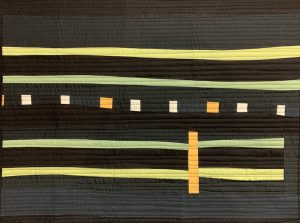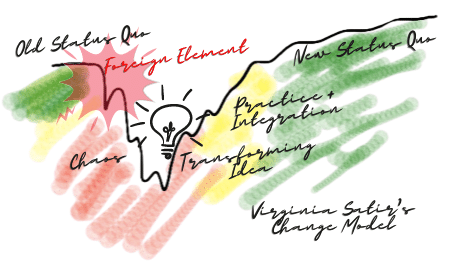I had the privilege to study with a renowned artist, Nancy Crow. It was a wonderful experience. Of course I learned about art —design principles, use of color, figure ground tension. I also came smack up against an issue that I see in so many organizations: the desire for creativity while maintaining tight control. Let me explain.
I wanted my design exercises to be successful—adhering to the constraints of the exercise, while also being beautiful. Nancy walked the room, pausing to comment on work-in-progress. Her first comment on my work was, “that’s a gem.” Woohoo! I kept going with my original idea, changing scale, and adding elements. Nancy came around again. “Those are boring. You’re trying to control the outcome.” Ooof. In trying to ensure a successful outcome, I’d obtained a prosaic and not very creative result.
In organizations, the desire to control the outcome shows up as over-specifying, over-planning, controlling, and driving out variation. While the outcome may be serviceable, chances are pretty good it won’t be astonishing, delightful, or a breakthrough innovation.
Yet, it is hard to trust that something wonderful will emerge when we loosen up on control. The key for me is to articulate what is really essential–the minimum specification–and leave the rest open–in art and in organizations.
Leave Room for Something Wonderful
1. Focus on outcome. What is the problem to be solved or benefit that will come about? What should the experience of using the proposed product or solution be?
2. Set constraints. Constraints establish boundaries. These are the minimum specifications, that taken with the outcome communicate essential need and essential limits. Constraints may relate to time, expense, form.
3. Identify veto conditions. When you unleash creativity, people will come up with stuff you never imagined. That’s usually good, but sometimes it it very, very bad—like the time a group in a workshop designed a death camp simulation for their classmates. Nope. Think about what would be impermissible for moral, legal or regulatory reasons. You don’t have to list them all (you won’t think of them all). Give a couple of examples, which will remind people to consider what might be out of bounds as they audition ideas.
I’ve been working this way with my clients and in my workshops. The results are often wonderfully creative—in ways that I never would have imagined. Now, I need to figure out how to do it for my art.










0 Comments